 |
|
|
Guyana (Guiana) Tour |
||
|
||
|
|
||
|
|
Georgetown's history goes back to the 1600's, a time when the Dutch were
the people calling the shots -- who else would establish a capital city that is
2 meters below sea level. They traded domination over the territory with the British for
a period, before the British final secured this section of the South American
coast for themselves -- the Dutch took the next parcel to the east. The architecture of Georgetown reflects both
traditions. It is also known as "The Garden City" for its tree-lined
avenues -- only in the older sections of town. Despite the moniker, it is hard to find people who are dazzled by Georgetown -- especially outside of the city -- but it is worth a swing through to see a few historical tour. |
|
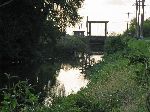 |
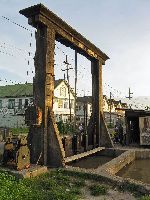 As
noted above, Georgetown is below sea level and bordered by the ocean and a river
so it is protected by a seawall and dikes. Spaced along these barriers are
"sluices" (canals) and "kokers" (sluice gates). At low tide they can be
opened to drain the city. At times they have collapsed and inundated the
town. If there are heavy rains in a period without very low low-tides. As
noted above, Georgetown is below sea level and bordered by the ocean and a river
so it is protected by a seawall and dikes. Spaced along these barriers are
"sluices" (canals) and "kokers" (sluice gates). At low tide they can be
opened to drain the city. At times they have collapsed and inundated the
town. If there are heavy rains in a period without very low low-tides.These two pictures were taken within a few minutes of each other. In the picture of just the koker, you can see the water at the top of the wall. In the picture of the sluice, you can see several meters of dry gate. |
|
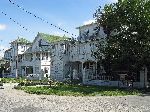 |
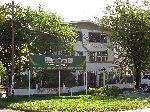 A lot of the intrigue and interest of strolling around
Georgetown is created by the mixed use and eclectic character of the city. A lot of the intrigue and interest of strolling around
Georgetown is created by the mixed use and eclectic character of the city.The building on the right is the Office of the Leader of the Opposition. |
|
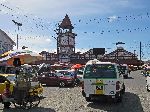 |
|
|
|
|
|
|
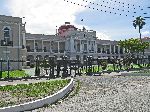
|
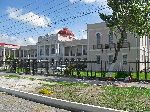 At
the edge of the market is the People's House, Parliament. The
foundation stone was laid by Architect
Joseph Hadfield in 1839. The design conforms to Tuscan architecture. The
ceiling of the Parliament Chamber reflects the architectural genius of Castellani. It is an excellent example of 19th century Renaissance architecture
and is one of the two domed buildings in the city. Within its compound are two
canons that were used in the Cimmerian War and a statue of Hubert Nathaniel
Critchlow, OBE [1884 –1958] who is regarded as the father of Trade Unionism
in Guyana. At
the edge of the market is the People's House, Parliament. The
foundation stone was laid by Architect
Joseph Hadfield in 1839. The design conforms to Tuscan architecture. The
ceiling of the Parliament Chamber reflects the architectural genius of Castellani. It is an excellent example of 19th century Renaissance architecture
and is one of the two domed buildings in the city. Within its compound are two
canons that were used in the Cimmerian War and a statue of Hubert Nathaniel
Critchlow, OBE [1884 –1958] who is regarded as the father of Trade Unionism
in Guyana.
|
|
| St. Andrew's Kirk (no photo) | Facing Parliament is St Andrew's Kirk, the oldest surviving church in the city. In another chapter of the Dutch-British flip-flops, the Dutch Reformed congregation laid the churches foundations in 1811. However, due to financial difficulties it was acquired by Scottish Presbyterians and was formally opened for service on 28 February 1818. | |
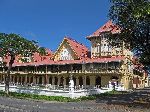 |
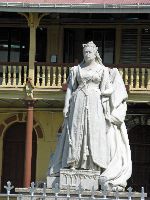 The
High Courts were designed by C. Castelanni and opened in May 1887. The
High Courts were designed by C. Castelanni and opened in May 1887.
A large and imposing statue Queen Victoria stands majestically in front of the building. |
|
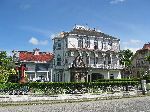 |
The City Engineers Department has procured a distinctive building next to the High Courts on Avenue of the Republic. So far we haven't come across any historical information on the building. It has nice ironwork on the veranda. | |
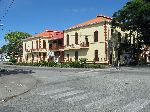 |
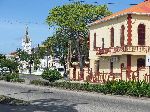 The
Georgetown Magistrates Court was constructed in 1897, as an extension to accommodate the legal proceedings.
Decorative ironwork is a prominent feature above doors and the main entrance. The
Georgetown Magistrates Court was constructed in 1897, as an extension to accommodate the legal proceedings.
Decorative ironwork is a prominent feature above doors and the main entrance. |
|
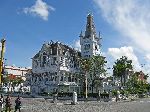 |
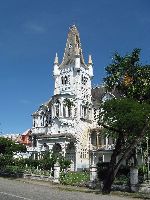 With
its spires, steeples, arches and pedigree City Hall could pass as a church, but it the City Hall.
One description calls it “Fancy dress Gothic Revival". It was designed by
Jesuit Priest Rev. Ignatius Scoles. The foundation stone was laid in 1887. It
opened in 1889. With
its spires, steeples, arches and pedigree City Hall could pass as a church, but it the City Hall.
One description calls it “Fancy dress Gothic Revival". It was designed by
Jesuit Priest Rev. Ignatius Scoles. The foundation stone was laid in 1887. It
opened in 1889. |
|
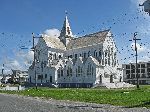 |
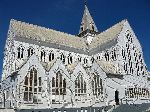 St
George's Cathedral in
Georgetown claims to be the tallest free-standing wooden structure in the world. Begun
in 1877, it opened in 1893. It was constructed mainly of greenheart and English
Oak, by Sir Arthur Blomfield (1829-1899), a prolific architect and 1891 Royal
Institute of British Architects gold medalist. St
George's Cathedral in
Georgetown claims to be the tallest free-standing wooden structure in the world. Begun
in 1877, it opened in 1893. It was constructed mainly of greenheart and English
Oak, by Sir Arthur Blomfield (1829-1899), a prolific architect and 1891 Royal
Institute of British Architects gold medalist. The exterior detail is quite magnificent and interior is especially elegant. |
|
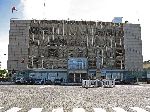 |
The 'modern' building on the street is the featureless Bank of Guyana.
The building was officially opened on 11 October
1966.
|
|
| National Library (no photo) | Previously the Public Free Library was built in 1909. Andrew Carnegie; a Scottish born American industrialist and philanthropist provided financing for the construction and furnishing of the building. The building once housed the Economic Science, Anthropological and Historical sections of the National Museum. In 1951, the Museum was relocated to its present site down the street and the Library took over the entire building. [As part of the same initiative a total of 2,509 Carnegie libraries were built around the world between 1883 and 1929: 1,689 were built in the United States, 660 in Britain and Ireland, 125 in Canada, and others in Australia, New Zealand, Serbia, the Caribbean, Mauritius and Fiji.] | |
|
|
The beautiful wooden Church of the Sacred Heart was built by Father Schembri, an Italian. A fine example of renaissance architecture, the church was constructed during 1859 – 1861 and was opened at midnight mass on 25 December 1861so that the Portuguese community could celebrate mass in their own language. | |
|
|
Georgetown has numerous heritage buildings, like what is now the Walter Roth Museum. The house shows a good example of "Demerara shutters". The shutters cant out from the side of the building, leaving a shelf at the bottom. Before air-conditioning, a block of ice would be left on the shelf, cooling air as it blew into the building. | |
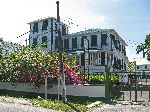 |
In the same style as the previous building, this typical Georgetown heritage building houses the National Trust of Guyana and several other enterprises. The National Trust of Guyana is a government enterprise, established in 1972, whose mandate is to the preservation and conservation of historic buildings and sites in Guyana. Many vernacular features, predominantly the ‘Demerara Windows’ and the ‘Georgian six paned windows' characterize the building. | |
 |
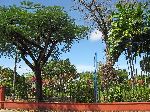 The
land of Promenade
Gardens was originally part of the Parade Grounds (1812), which doubled as
the city's Cricket grounds. It is now called Independence
Park (1966) and is still across Middle Street from Promenade Gardens.
The garden was developed as an ornamental garden for Government House.
It was extended to its present size in 1884. It is laid out in
Victorian style without a lawns and vistas. Its
peaceful appearance belies a torrid past as slaves involved in the 1823 East
Coast Rebellion were publicly hanged there. The
land of Promenade
Gardens was originally part of the Parade Grounds (1812), which doubled as
the city's Cricket grounds. It is now called Independence
Park (1966) and is still across Middle Street from Promenade Gardens.
The garden was developed as an ornamental garden for Government House.
It was extended to its present size in 1884. It is laid out in
Victorian style without a lawns and vistas. Its
peaceful appearance belies a torrid past as slaves involved in the 1823 East
Coast Rebellion were publicly hanged there. |
|
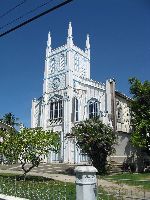 |
Christ
Church (left) was established in 1836, as a result of disagreements within the
congregations of the St. Georges Cathedral -- making it one of the oldest
churches in Georgetown. The present church has a slight
resemblance to the second St. Georges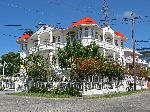 cathedral,
which was built in 1842
-- the current St. Georges' opened in 1893. cathedral,
which was built in 1842
-- the current St. Georges' opened in 1893.Between Christ Church and Christ Church School is a very nice house. We haven't been able to determine if it is associated with either. |
|
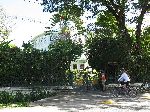
|
This
house with its 100 windows and high living fence, was built during the 1820s on land belonging to
the Anglican Church in British Guiana. Several governors including, Governor Lyght and Governor Barclay, resided there. A rent of 240.00 pounds each
month was paid by the governors who resided there.
In 1852 and 1863 an ordinances legislating the purchase of the building to
establish a home for the British governors were passed.
The original
building had two stories and a double stairway and faced Carmichael Street
(now in the rear).
Over time many changes were made to the building an adjacent lots numbers 57
to 60 on Main Street and 93 to 95 on Carmichael Street were incorporated. |
|
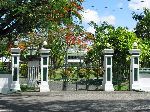 |
Also quite obscured from the street, the Prime Ministers residence is a good example of mid-nineteenth century Georgetown wooden architecture. It demonstrates an Italianate influence; characterized by the square cupola at the top and the portico below it. This building was once the residence of the British High Commissioner. | |
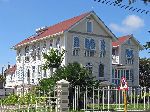 |
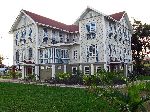 This
is the location of the original Kingston House, the residence of the
Archbishop of Guyana, which was demolished in 1894. A new traditional timber
house, with characteristics of Victorian architecture, was built the same
year. It was renamed Austin House in 1921. Renovations were done in 1930
and 1950. There is story that the house was located much closer to the
street and the Bishop's nine children threw objects at people passing so the
house was moved westwards, but this legend seems to be associated with
the original Kingston House. This
is the location of the original Kingston House, the residence of the
Archbishop of Guyana, which was demolished in 1894. A new traditional timber
house, with characteristics of Victorian architecture, was built the same
year. It was renamed Austin House in 1921. Renovations were done in 1930
and 1950. There is story that the house was located much closer to the
street and the Bishop's nine children threw objects at people passing so the
house was moved westwards, but this legend seems to be associated with
the original Kingston House. |
|
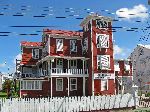 |
This building with its distinctive red color is situated in High Street, Kingston between Young and Barrack Streets. It is built of timber (pitch-pine) and is covered with red wallaba shingles. It is not certain whether the verandah and the ground floor were part of the original building. The Red House was acquired in 1925 by the Colony of British Guiana. Sir Eustace Woolford, a Speaker of the Legislature, was one of the early owners of the house. Between 1925 to 1953, numerous Colonial Secretaries resided there. Dr. Cheddi Jagan also lived there from 1961 to 1964 while he served as Premier of British Guiana. Subsequently from 1965 to the early 1990's the Red House was used as government offices e.g. the Public Service Ministry. The house was left vacant until 1999 when the Cheddi Jagan Research Centre was established in the building. The center is dedicated to making available, to Guyana and the world, the works of Dr. Cheddi Jagan, (1918-1997), and an archive related to his long and enduring involvement in the political life of Guyana, and a historical record of that period. |
|
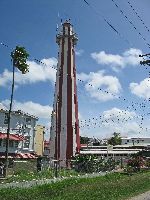 |
Interestingly, Georgetown's Lighthouse is situated near the mouth of the Demerara
River, but inland and approximately a quarter mile from the port of
Georgetown. The foundation stone of the present building was laid in
1830, replacing a wooden lighthouse which was constructed by the Dutch in
1817.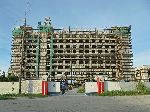 Down the street from the inland lighthouse, on the coast, on prime real estate, at least as tall as the lighthouse, is a Chinese construction project (2013), with every indication of becoming the tallest and biggest hotel in town. |
|
|
Umana Yama means “meeting place of people”. It is modeled after the traditional house of the Wai-Wai People. This building in Georgetown is used for conferences and community events. It was built in 1972 as a VIP lounge for the Non-Aligned Foreign Ministers Conference. It is 55 feet (16.8 m) high. The roof is made of troolie palm leaves. The four tall "bull forehead" greenheart poles, to the right, were originally encased in a jasper stand on a granite boulder. This monument to the African Freedom Fighters which was erected in the compound of the Umana Yana when the United Nations Commission met in Georgetown in 1974. It was unveiled by former President, the late Linden Forbes Sampson Burnham on 26 August 1974, and ‘Namibia Day'. |
||
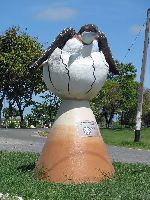 |
Guyana Marine Turtle Monument, just outside of Umama Yama, illustrating the life of a newly hatched Leatherback turtle as it crawls out of its shell. It was erected by the Guyana Marine Turtle 2001 Conservation Organization to increase the awareness of the public to their natural heritage. | |
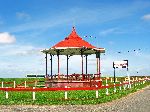 |
An interesting amenity that adds an accent to the surroundings is the iron Seawall Bandstand, near the west end of the Georgetown seawall. It is one of three similar bandstands in Georgetown. It was commissioned by Sir James Alexander Swettenham (1846-1933), who was at that time the Governor of British Guiana and financed by public subscription in 1903 in memorial to Her Majesty Queen Victoria who died in January 1901. . During the colonial era, the bandstand was used for performances by the British Guiana Militia Band. | |
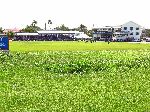 |
Cricket is a national passion in Guyana. There are about 150 cricket clubs in the country, or one for every 5000 people. This the Everest Cricket Ground, which is across the road from the Malteenoes Sports Club, which is also mostly about cricket. These and other cricket grounds in Guyana were used when they hosted the Cricket World Cup in 2007. | |
 |
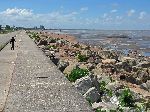 Parts of Georgetown are three to six feet below sea level so a sea wall is
necessary to keep the city dry.
Parts of Georgetown are three to six feet below sea level so a sea wall is
necessary to keep the city dry.
The path along it is used for walking and jogging, but between the silt
(exacerbated by inland mining |
|
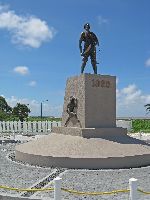 |
The 1823 Memorial was designed and sculpted by Ivor Thom. Unveiled in August
2013.
It is "Dedicated to the memory of the millions who courageously and unceasingly waged the war of Africans in the New World and especially to the hundreds who in the pursuit of their inalienable rights to be free human beings, were slaughtered by the agents of an unthinkable colonial administration. "Gone but not forgotten. Their struggles made out world possible. All Guyana salute their valour." |
|
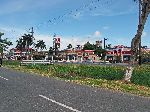 |
Vlissingen Road Road, Kitty, was one of the first sections of Georgetown to get a cluster of fast food restaurants. I guess this signals that it is automobile oriented and presumably middle class. The area certainly move away from human scale and walking-friendly. | |
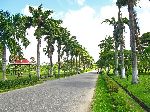 |
A loan of $50,000.00 was raised for the purpose of lying out the gardens and to
purchase the site. The Government purchased 184 acres of
the old coffee estate Vlissingen from Joseph Bourda for the purpose of
establishing a Botanic Garden and station. In 1878, American John Frederica
Wady arrived here and spent thirty-five years landscaping one of the finest
tropical gardens in South America. At first a board of directors was
appointed to advice on the proceedings but this board was soon dissolved in
1893 and the supervision devolved on the superintendent. Housed in these gardens are the Seven Ponds Monument and the Mausoleum a tribute to the nation's heroes. Sir David Rose, Governor General of British Guiana and former president Mr. Linden Forbes Sampson Burnham are amongst those buried there. It includes one of three Georgetown bandstands. The Kissing Bridge is another noteworthy feature of the Botanical Gardens. Within the garden is the National Zoo. It has a collection containing main indigenous animals and plants. |
|
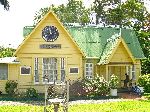 |
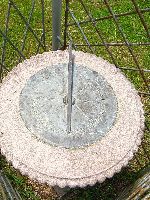 The
Jenman Education Centre is named for British government botanist, George Samuel Jenman
(1845-1902). Jenman trained in gardening and botany at Kew Gardens, London. He
was Superintendent of Castleton Botanical Garden, in Jamaica, from 1873 to
1879
and Superintendent of the Botanical Garden, here, from 1879 to 1902. There is a
sundial in the front yard. The
Jenman Education Centre is named for British government botanist, George Samuel Jenman
(1845-1902). Jenman trained in gardening and botany at Kew Gardens, London. He
was Superintendent of Castleton Botanical Garden, in Jamaica, from 1873 to
1879
and Superintendent of the Botanical Garden, here, from 1879 to 1902. There is a
sundial in the front yard. |
|
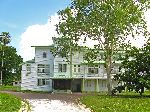 |
Next door to the Botanical Garden is Castellani House. It was originally designed and built in 1879 to be the official residence of the Superintendent of the Botanical Garden by the Maltese colonial architect Cesar Castellani. Castellani was one of the most prominent and prolific architects of the colonial era in British Guiana. Dissatisfied with the original design of the house, Jenman refused to move into the residence until the changes he demanded had been implemented. These changes were completed in 1882, and Jenman moved into the house in that year. After Jenman’s death in 1902, Castellani House was the residence of the Director of Agriculture. In 1942, the house was extended with the addition of a third storey to the original two. In 1965 the building was converted as the official residence by Mr. Linden Forbes Sampson Burnham, then Prime Minister of British Guiana. In 1993 the inaugural collection of the National Art Gallery was held. | |
 |
This
monument was unveiled by former President Burnham on 23 May 1976. It
commemorates the 1763 slave rebellion; the first revolt that came close to
being successful. Cuffy, an Afruican slave, as the leader of this insurrection, is an official
national hero. Here, his legacy has been immortalized in bronze.
Surrounded by a small garden, this monument has been described as the ‘Greatest Standing Sculpture of the Caribbean,’ by British based painter Aubrey Williams. It signifies the struggle of the Guyanese for their liberation and was the first sculpture of bronze in Guyana. To construct it, the model was cut into various sections, molds made and cast in bronze and then reassembled through welding. |
|
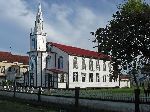 |
Smiths Congregational Church
was built in honor of the Reverend John Smith (1790-1824). The foundation stone was laid
in November 1843. The timber structure, which features a steeple above the
main entrance, was opened in August 1844 -- twenty years after his premature
death.. Construction was supervised by
Rev. E Angel Wallbridge. Rev Smith was educated in England. He stayed there until December, 1816, when he was ordained a missionary by the London Missionary Society. He arrived in Guyana in February, 1817. Rev Smith was stationed at Plantation Le Rssouvenir, with the purpose to evangelize and teach the enslaved workers in the area. His actions antagonized the plantation owners and he was charged with treason and sentence to death for inciting the Demerara Rebellion of 1923. He died in prison on 6 February 1824 and is remembered as the Demerara Martyr. He is especially remembered for his denunciation of the poor living and working condition of the enslaved people. |
|
|
"Hosted by
DreamHost - earth friendly web hosting"
|
||
 Guyana
Cultural Tour: Georgetown
Guyana
Cultural Tour: Georgetown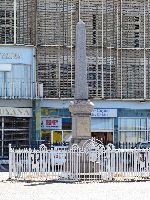
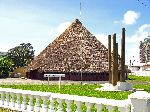
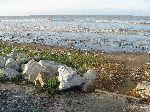
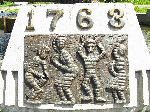




 Please
contact us
Please
contact us